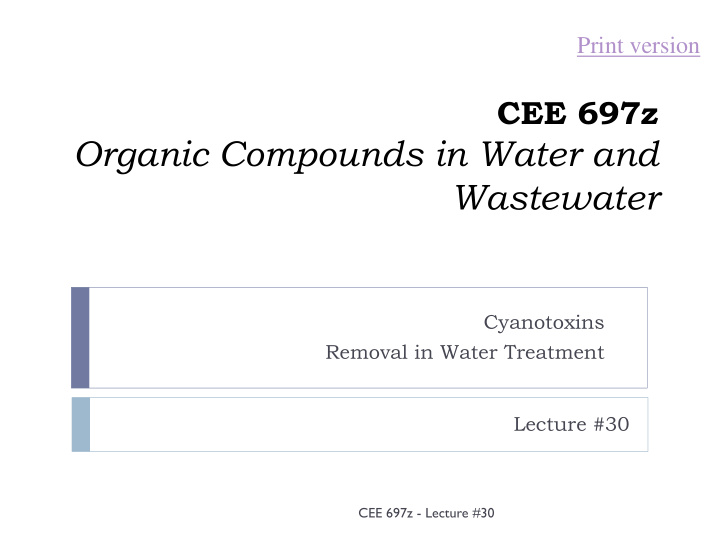



Print version CEE 697z Organic Compounds in Water and Wastewater Cyanotoxins Removal in Water Treatment Lecture #30 CEE 697z - Lecture #30
WRF Reports on Cyanotoxin Control Newcombe, 2002 (WRF 446) Removal of Algal Toxins from Drinking Water Using ozone and GAC WRF 2839; Treatability of Algal Toxins using Oxidation, Adsorption and Membrane Technologies (2010) Newcombe, 2009 (WRF 3148) International Guidance Manual for the Management of Toxic Cyanobacteria, Global Water Research Coalition Project (2010) WRF 4016; Evaluation of Integrated Membrane Systems for T&O and Algal Toxin Control (2012) Wert et al., 2014 (WRF 4406) Release of Intracellular metabolites from Cyanobacteria during Oxidation Processes Newcombe, 2015? (WRF 4315) Optimizing Conventional Treatment for Removal of Cyanobacteria and Toxins (in progress)
Water Treatment Fig. 6 Overview of drinking water treatment and the overall impact on cyanobacteria and cyanotoxins. Merel, S., Walker, D., Chicana, R., Snyder, S., Baures, E. and Thomas, O. (2013) State of knowledge and concerns on cyanobacterial blooms and cyanotoxins. Environment International 59, 303-327.
Chlorine and Mycrosystins
Chlorination Fig. 2 Formation of dihydroxy- microcystin from reaction with chlorine Merel, S., Walker, D., Chicana, R., Snyder, S., Baures, E. and Thomas, O. (2013) State of knowledge and concerns on cyanobacterial blooms and cyanotoxins. Environment International 59, 303-327.
Chlorination Fig. 3 Formation of 5-chloro- cylindrospermopsin and cylindrospermopsic acid from reaction with chlorine Merel, S., Walker, D., Chicana, R., Snyder, S., Baures, E. and Thomas, O. (2013) State of knowledge and concerns on cyanobacterial blooms and cyanotoxins. Environment International 59, 303-327.
Dose: Residual Curves Ozone and Cyanotoxins Newcombe, 2002 (WRF 446) Removal of Algal T oxins from Drinking Water Using ozone and GAC Water Quality Characteristics
Ozone and Microsystin Lab Grade water??
Ozonation of Microsystin Newcombe, 2002 (WRF 446) Removal of Algal T oxins from Drinking Water Using ozone and GAC
Ozonation of Anatoxin-a Newcombe, 2002 (WRF 446) Removal of Algal T oxins from Drinking Water Using ozone and GAC
Ozonation of Saxitoxins Newcombe, 2002 (WRF 446) Removal of Algal T oxins from Drinking Water Using ozone and GAC
Structural Refresher Anatoxin-a Microsystin Saxitoxin Cylindrospermopsin CEE 697z - Lecture #30
Comparison in Myponga Water Newcombe, 2002 (WRF 446) Removal of Algal T oxins from Drinking Water Using ozone and GAC
GAC removal of Saxitoxins Hope Valley water
GAC and more Saxitoxins Newcombe, 2002 (WRF 446) Removal of Algal Hope Valley Water T oxins from Drinking Water Using ozone and GAC
GAC removal of Microsystins
Newcombe, 2002 (WRF 446) Removal of Algal T oxins from Drinking Summary Water Using ozone and GAC
Oxidation: Summary Kinetics Wert et al., 2014 (WRF 4406) Release of Intracellular metabolites from Cyanobacteria during O id i P
Structural Refresher Anatoxin-a Microsystin Saxitoxin Cylindrospermopsin CEE 697z - Lecture #30
Wert et al., 2014 (WRF 4406) Release of Intracellular metabolites from Cyanobacteria during Oxidation Processes
Wert et al., 2014 (WRF 4406) Release of Intracellular metabolites from Cyanobacteria during Oxidation Processes
Membrane removal of Cylindrospermopsin
Control of Intracellular cyanotoxins
Control of Extracellular Cyanotoxins
Cylindrospermopsin
From: Cyanobacteria and Cyanotoxins: Information Treatment summary for Drinking Water Systems , USEPA , July 2012 da
From: Sklener, Westrick & Szlag, 2014 Managing a Cyanotoxin Event
From: Sklenar, Westrick & Szlag, 2014
From: Sklenar, Westrick & Szlag, 2014
From: Sklenar, Westrick & Szlag, 2014
From: Sklenar, Westrick & Szlag, 2014
WTP Response to an HAB Event Do not use pre ‐ chlorination for improved coagulation or reduced coagulant dosing during a cyanobacterial bloom unless comprehensive testing has identified a dose high enough to destroy released toxins. Do not apply pre ‐ chlorination when cyanobacteria producing MIB or geosmin are present. Potassium permanganate dosing may be applied for the control of manganese and iron in the presence of A. circinalis and M. aeruginosa. Practice pH control to pH > 6 if this is not part of normal operations. This will reduce the risk of cell lysis and metabolite release during treatment. Optimize NOM removal using the criteria Δ C/C0 DOC, UV, and color ≤ 0.05 and the cell removal should be optimized as well. While turbidity cannot be used as an indicator of the presence of cyanobacteria or cell concentration, use the decrease in settled water turbidity with coagulant dose as a surrogate for, or indicator of, cell removal if the initial turbidity is ≈10 NTU or above. If the presence of cyanobacteria results in increased coagulant demand to achieve improved settled water turbidity the application of a particulate settling aid, or even powdered activated carbon, may lead to improvements. Although removal of cyanobacteria through conventional coagulation can be very effective, 100% cell removal is unlikely in normal full scale operations. In the event of high cell numbers entering the plant monitor for cell carryover and accumulation in clarifiers, this can lead to serious water quality problems if not rectified. Once captured in the sludge, cyanobacteria can remain viable and multiply over a period of at least 2 ‒ 3 weeks. Simultaneously, within one day some cells in the sludge will lyse and release NOM and metabolites. Newcombe, 2014 (WRF 4315, in progress) Optimizing Conventional Treatment for Removal of Cyanobacteria and T oxins
To next lecture CEE 697z - Lecture #30
Recommend
More recommend